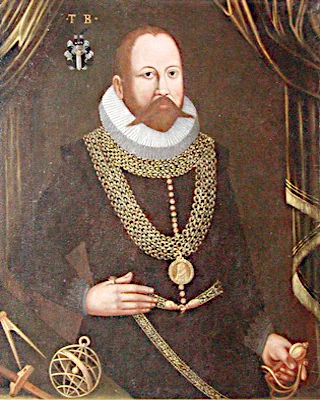
Tycho Brahe (1546 – 1601), whose full name was Tyge Ottesen Brahe, was a Danish astronomer born on December 14, 1546 at Knudstrup Castle, into a high nobility family. His father, Otte Brahe, was governor of Helsingborg Castle, and his mother, Beate Bille, belonged to a powerful Danish family.
At the age of 13, he began studying law at the University of Copenhagen, but a solar eclipse in 1560 (which he predicted with remarkable accuracy) led him to turn to astronomy. In 1566, during a duel with a cousin over a mathematical quarrel, he lost part of his nose, which he later replaced with a metal prosthesis (probably made of gold and silver).
In 1576, King Frederick II of Denmark (1534-1588), impressed by his talents, offered him the island of Hven and considerable funds to build an observatory. Brahe built Uraniborg ("the castle of the sky"), the first modern astronomical observatory, equipped with giant instruments:
Although these instruments were not optical (the astronomical telescope had not yet been invented), they allowed measurements of unprecedented precision (up to 1 arc minute). For 20 years, Brahe made the most precise observations of his time there, with a team of more than 20 assistants.
Brahe proposed a hybrid cosmological model, called the Tychonic system, which attempted to reconcile:
In this system:
Although incorrect, this model was widely adopted before the work of Galileo (1564-1642) and Kepler (1571-1630), as it explained observations without contradicting Scripture.
Brahe's observations were revolutionary:
| Discovery/Observation | Date | Significance |
|---|---|---|
| 1572 Supernova (in Cassiopeia) | November 11, 1572 | Proved that the heavens were not immutable (contrary to Aristotelian philosophy) |
| 1577 Comet | November 13, 1577 | Showed that comets were celestial phenomena (not atmospheric) |
| Catalog of 777 fixed stars | 1577-1597 | Unprecedented precision (error < 1 arc minute), later used by Kepler |
| Precise measurements of planetary motions | 1580-1597 | Essential data for Kepler's laws of elliptical orbits |
| Observation of Venus phases | 1580s | First systematic observations (though not understood as evidence for heliocentrism) |
In 1597, after the death of Frederick II, Brahe came into conflict with the new king Christian IV (1577-1648) and left Denmark. He settled in Prague in 1599, where he became Imperial Mathematician to Emperor Rudolf II (1552-1612). It was there that he hired Johannes Kepler (1571-1630) as an assistant in 1600.
Brahe died suddenly on October 24, 1601, officially from a urinary infection (according to accounts, he refused to leave a banquet table to urinate out of politeness). His last words to Kepler were reportedly: "Let me not have lived in vain."
His scientific legacy is immense:
The instruments designed by Brahe represented the pinnacle of pre-telescopic technology:
| Instrument | Description | Precision | Use |
|---|---|---|---|
| Mural Quadrant | 1.8 m radius brass arc, fixed to the wall | ±1 arc minute | Measuring star altitudes |
| Armillary Sphere | 1.5 m diameter celestial sphere model | ±2 arc minutes | Determining equatorial coordinates |
| Sextant | 1.6 m radius instrument with sights | ±1.5 arc minutes | Measuring angular distances between stars |
| Equatorial Armillary | Instrument for following diurnal motion | ±1.5 arc minutes | Observing planets |
| Celestial Globe | 1.5 m diameter sphere with positioned stars | N/A | Teaching and visualization |
Brahe's system was an attempt to compromise between existing models:
| Model | Description | Advantages | Disadvantages |
|---|---|---|---|
| Ptolemaic | Earth at center, planets on epicycles | Compatible with Scripture and Aristotle | Increasing prediction errors |
| Copernican | Sun at center, Earth in motion | Better explains planetary motions | Contrary to Scripture and common sense |
| Tychonic | Earth at center, Sun orbits Earth, other planets orbit Sun | Explains observations without Earth's motion | Mathematical complexity similar to Ptolemaic system |
| Year | Event | Context |
|---|---|---|
| 1546 | Born at Knudstrup Castle, Denmark | High Danish nobility family |
| 1560 | Accurately predicts a solar eclipse | Beginning of his interest in astronomy |
| 1566 | Loses part of his nose in a duel | Conflict with a cousin over a mathematical question |
| 1572 | Observes the supernova in Cassiopeia | Publication of De nova stella |
| 1576 | King Frederick II gives him the island of Hven | Beginning of Uraniborg construction |
| 1577 | Observes the great comet | Proves that comets are celestial phenomena |
| 1597 | Leaves Denmark for Prague | Conflict with new king Christian IV |
| 1600 | Hires Johannes Kepler as assistant | Collaboration that would change astronomy |
| 1601 | Dies in Prague | From urinary infection complications |
| 1604 | Kepler's supernova observation (posthumous) | Use of his data by Kepler |
Brahe's life and work have inspired many works: